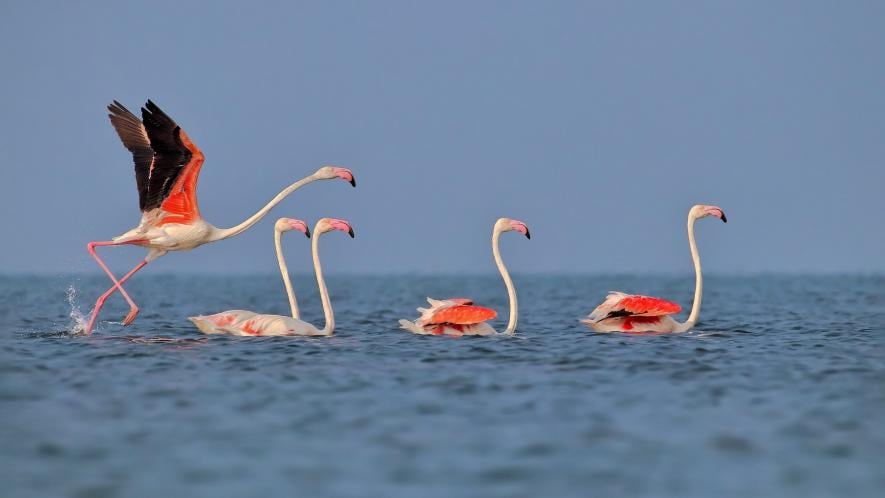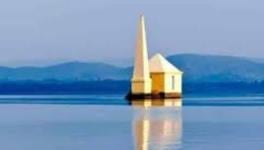Chilika, Shrinking ‘Queen of Nature’, Wails For Attention: Biswajit Mohanty

Image Courtesy: PixaHive
Biswajit Mohanty, who heads the Wildlife Society of Odisha, and is an ardent tracker of the changing dynamics of Chilika Lake and an environmental activist of international repute. NewsClick spoke with the wildlife expert on the current state of Chilika lake, the rising silt and prawn cultivation that is threatening its rich flora and fauna. Edited excerpts:
D N Singh: There has been a lot of romanticisation surrounding the world-famous Chilika Lake in Odisha. Many nature lovers and poets have described it as the ‘Queen of Nature’. What makes Chilika so significant as a wetland in the world?
Biswajit Mohanty: Considered to be the second largest brackish water lagoon in the world next to the lake Baikal in Russia [although Baikal is a freshwater lake], Chilika is spread across the Puri district in Odisha. Spread over an area of between 900 and 1,165 sq km, it is fed by 52 freshwater rivers and rivulets. It is famed for its unique estuarine character created by the rare amalgamation of fresh water and seawater.
Its water spread often varies due to the literal drift from the Bay of Bengal. This is very unique but its gradual neglect requires it to be addressed on a war footing. If lagoons like Chilika are ephemeral, then the days are not far when the lagoon may also become a part of the sea or be reduced to a marshy wetland unworthy of the significance it enjoys.
DNS: What is causing its shrinkage and what will be the likely impact?
BM: There has been a huge shrinkage of the lagoon over time and at present, it has suffered more due to heavy siltation. According to official records, the lagoon shrunk resulting in the reduction of its depth from 2.4 meters to about little less than 1.5 m. As per official records and the Chilika Development Authority (CDA), the lake is distanced by 4-5 km from the habitations of fishermen, which is unfortunate, as over one 0.2 million fisherfolk families depend on the catch from the lake. Not only the livelihood of the fishing community but the revenue from the fish catch has suffered substantially. Even heavy siltation and shrinkage have become the major catalysts to choke the 32 km long and 1.5km width channel connecting it with the Bay of Bengal.
DNS: What is the importance of the channel linking the lagoon with the sea?
BM: Minus the channel, the Chilika Lagoon will be nothing but an ordinary lake or an extension of the sea. Once the channel suffers from choking, that will severely affect the exchange of brackish water and seawater, which plays a major role in making the lake a domain of estuarine, housing hundreds of flora and fauna.
What has added to its woes is the rapid increase in commercial activities in the past one decade or more, mainly illegal prawn cultivation in and around the lake further aggravating the silt load and shrinkage.
DNS: What do you think are the other major factors, apart from prawn culture, that are posing a threat to Chilika lake?
BM: So many. There are laws prohibiting prawn cultivation but sadly there is an astounding absence of implementation of these laws, which is giving unbridled monopoly to prawn cultivators. But, it cannot alone be the reason for the loading of silt in the lake.
DNS: How do you look at the changing dynamics after the opening of a new mouth into the sea?
BM: Any imbalance in the ingress of sea water and fresh water outflow ushers in excess salinity from the sea, which kills flora and fauna and turns many areas of the lake marshy.
In 2000, there had been a clinical intervention by dredging the silted outer channel and opening a new mouth connecting Chilika with the sea, thus facilitating a balance in exchange of water from both sides and reducing siltation.
Once the estuarine character of Chilika water gets disturbed then the lake is left as a minor extension of the sea. And the increase in salinity due to excess sea water drives many species to perish, which has already happened.
DNS: Was there a need to adhere to certain guidelines before the dredging. What went wrong?
BM: Before dredging the opening into the sea, the National Institute of Oceanography (NIO), Goa, had started a model study on the dynamics of the proposed new mouth, but before the NIO could initiate the study inside the Chilika lagoon, the new mouth was dredged rather clinically in a haste, which raised many eyebrows among experts.
In the case of such an ephemeral eco-system like Chilika, a mere model study is not enough. Instead, the CDA should have had the patience to wait till NIO finished the study.
DNS: What is the state of the new mouth as of now?
BM: While the CDA dredged the opening into the Bay, it was for 100 meters but, the literal drift played its trick and by now the new mouth has increased to over 400 meters, thus creating a situation on which neither the CDA nor anyone else has any control.
During stormy tidal surges, excess water from the sea gushes into the lake and that extra load of salinity has been playing havoc in the lake, seriously affecting the brackish characteristic of Chilika water, which is visible.
[Nalabana Bird Sanctuary: Inside the lagoon, besides a few fantastic Islands for tourists, there is another signature feature -- the Nalabana bird sanctuary where lakhs and lakhs of migratory birds come during winters
‘Ramsar Site’: One of the hotspots of biodiversity in the country, Chilika has some rare, vulnerable and endangered species listed in the IUCN Red List of threatened animals. On account of its rich biodiversity, Chilika lake was designated as a "Ramsar Site", i.e. a wetland of International Importance.]
DNS: It is said that bird congregation at Nalabana has virtually shifted to another location. What are the reasons?
BM: Majority of birds cannot withstand more salinity in water. Even while perching on marshy areas. So, the famous wintering ground in Nalabana Bird Sanctuary now wears a forlorn look as the birds have shifted to a spot called Mangalajodi, where the security of the birds is also at stake.
DNS: What are the other threats for migratory birds?
BM: Poaching of many birds for their meat has become a craze and poachers always have a field day during winters.
DNS: In what way has fauna suffered?
BM: Some studies way back in 1985-1987 on the fauna at Chilika, done by the Zoological Survey of India, recorded over 800 species in and around the lagoon. The list includes a number of rare, threatened and endangered species including the Barakudia limbless skink.
Chilika Lake is a highly productive ecosystem, with rich fishery resources. The rich fishing grounds sustain the livelihood of more than 0.2 million fisherfolk who live in and around the lake. It has a great heritage value and maritime trade to the Far East used to take place from here.
Tourists and bird-watchers remain spell-bound by the largest congregation of migratory birds from large parts of Asia, particularly during the winters. The birds migrate from as far as the Caspian Sea, Lake Baikal, Aral Sea, remote parts of Russia, Kirghiz steppes of Mongolia, Central and South East Asia, Ladakh and the Himalayas to feed and breed in Chilika’s fertile waters.
DNS: What is the history of Chilika?
BM: It has been indicated in geological studies that in the Pleistocene era (Ice Age), the north-eastern region was lying under the sea and the coastline extended along the western shore of the lake.
Interestingly, this view is supported by the fact that the Konark Sun Temple (in Puri district), which was originally built on the seashore, is now about 3 km away from the coastline.
A fossil found on the south-western edge of the lake indicates the formation of the lake about 3,500 to 4,000 years ago.
DNS: Are Dolphins (Irrawaddy species) really the largest lagoon supported population here? Is there any evidence?
BM: It requires no empirical evidence that Chilika lake is an assemblage of marine, brackish and freshwater ecosystems that support amazing biodiversity. It is a home to the highly endangered Irrawaddy Dolphin. As per the 2013 Census, in which I was a team member, about 150 dolphins were found here and, therefore, here they are considered the largest lagoon-supported population in the world.
The writer is an independent journalist.
Get the latest reports & analysis with people's perspective on Protests, movements & deep analytical videos, discussions of the current affairs in your Telegram app. Subscribe to NewsClick's Telegram channel & get Real-Time updates on stories, as they get published on our website.




















